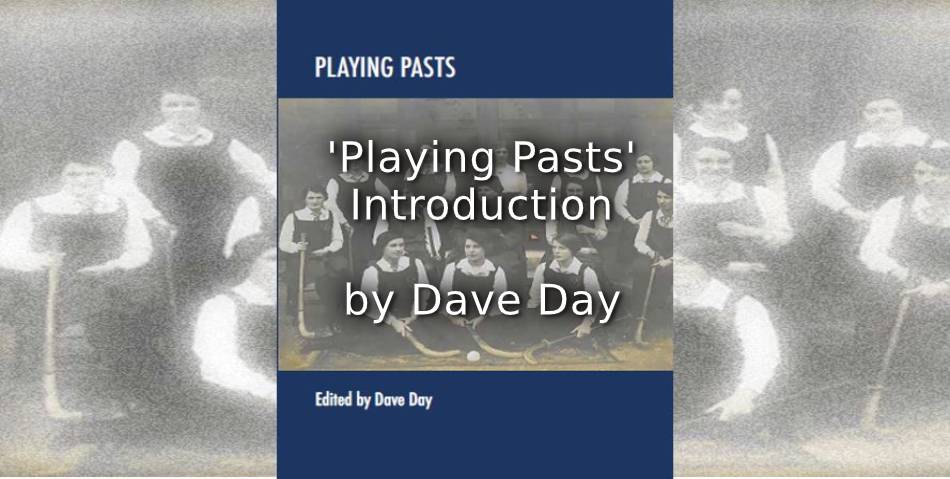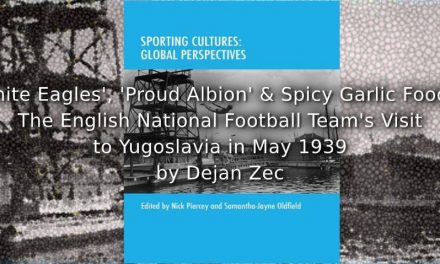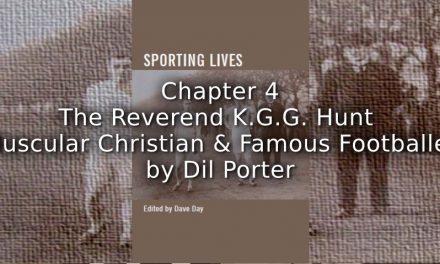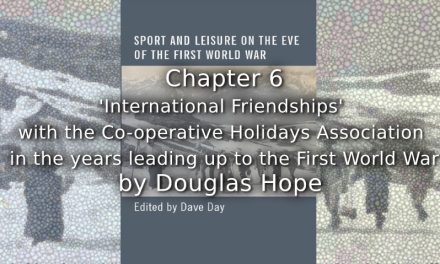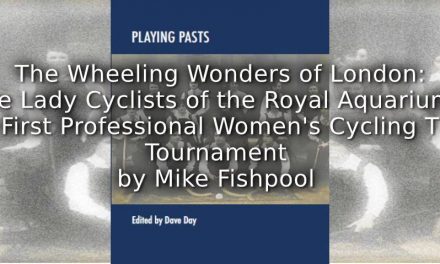Please cite this article as:
Day, D. Introduction, In Day, D. (ed), Playing Pasts (Manchester: MMU Sport and Leisure History, 2020), i-viii.
ISBN paperback 978-1-910029-56-5
Introduction
The digital era is changing history as it has been understood and practiced involving a shift in the traditional ontological, epistemological and methodological thinking that privileges the academic historian over public historians and academic histories over public histories. Digital technologies and platforms have accelerated the involvement of the public both as researchers and creators of histories who make their own meanings about the past without the mediation of professional historians. This popularization of history as practice and pursuit challenges the traditional separation between the distant and recent past. It also emphasizes that we need to regard history as something living, ongoing, and dynamic rather than quarantined to the past. For the sports and leisure historian, seeing history through this lens can broaden and change methodological practice.[1]
In response to these changes in the environment, Manchester Metropolitan University’s Sport and Leisure History (SpLeisH) research team hosted a seminar on the topic of the future for sports history as a sub-discipline of history in June 2015. This brought together academics involved in researching and teaching sport and leisure history with non-academic researchers and sporting heritage practitioners to reflect on the status of the field. The consensus was that the sports history community needed to do something different and this was reinforced the following year with the publication of a special issue of The International Journal of the History of Sport on methodologies, subsequently published as a book, [2] which explored the range of research tools and approaches now available to sports and leisure historians. This stimulated further thinking about ways in which research could be disseminated more widely and how the field could be extended to include both academic and non-academic interest groups. The online sports and leisure history magazine Playing Pasts (www.playingpasts.co.uk) emerged as a result.
Playing Pasts was launched in September 2016 to provide a platform for all sports and leisure history constituencies. As a free to access online magazine it was designed to make more widely available the research findings of British and International colleagues, most of which was being published in academic journals not easily available to the extensive worldwide community interested in the subject area. In addition, since a substantial proportion of the international sports history community operates outside of academia, the magazine was structured to engage independent, non-academic researchers and facilitate their activities through extending their networks and providing an outlet for their work. Further motivations for introducing Playing Pasts as an online magazine included the recognition within the SpLeisH research group of the urgent need to develop a higher status for this field of research and to enthuse and educate others about this area of history. In particular, the editorial team were keen to make visible issues surrounding gender and minorities in sport, as well as exposing hidden histories around place and identity. The overall aim was to generate a truly collaborative arena, widening knowledge through different networks of the importance of local histories, identifying lost individuals and communities, and connecting with international researchers and interest groups.
Thanks primarily to the time and effort invested by the Editor-in-Chief, Margaret Roberts, who has been in charge of its content since its inception, Playing Pasts now provides a unique opportunity for established scholars, early-career researchers, postgraduates, and non-academic practitioners from around the world to publicize their work in an accessible and visually arresting blog format, which appeals to communities that are often disconnected from Higher Education research agendas. Although there are a number of academic journals dedicated to the area, Playing Pasts is different in that it aims to present historical material related to sport and leisure in a widely readable and accessible format. The magazine is presented solely as an online publication and, while the main articles are invariably based on rigorous and traditional scholarly research, the material has been presented in shortened form and accompanied by numerous illustrations to allow the reader to explore and engage with a range of different ideas and research. The magazine is also different from other publications in that it is not divided into discrete issues, but material is added on a weekly basis, so there is always something fresh and new, while existing material is archived for easy reader access. Contributions are welcomed from anyone who feels they have something they would like to share about the history of sport and leisure, which is interpreted as widely as possible in this context, whether that be circuses or pantomime, fell walking or climbing, unusual or traditional sports, or anything else that historians have a passion about.
During the magazine’s first year, over 40 individuals from different scholarly constituencies showcased their research. Since then, the site has expanded rapidly and now 88 different authors have contributed, including 31 academics, 42 non-academics, 10 postgraduates, and 5 early-career researchers. The total access to date amounts to over 460,00, the site is now attracting over 21,000 reads per month, and the Playing Pasts twitter account currently has over 1,100 followers. Magazine content has included popular digests, such as ‘On this week in Sport and Leisure History’ and ‘Where Are They Now?’, which have been augmented by sections devoted to podcasts and videoed lectures. Further sections will be added over the course of the next few years in response to emerging areas of interest to sports and leisure historians.
The site is truly innovative: before its inception there was no global digital outlet for the public history of sports and leisure. Playing Pasts has not only allowed intellectual exchange between academic and public historians to thrive, it has also brought their work to new audiences, enabled democratic commentary and engagement through social media, and increased the credibility of the subject by highlighting its popularity within communities around the world. The magazine’s international reach is highlighted by the nationalities of those involved in contributing (including France, Belgium, Poland, Netherlands, Denmark, Canada, America, Italy, Serbia, Spain, Japan, Mexico, Australia, and Ireland) and by reading/viewing figures, which place the US (136,275), France (39,372), Germany (33,301), China (26,812), and Sweden (11,408) as the top five non-UK countries engaging with the site. Recent reader comments include: ‘As someone who, from birth, has never been interested in sport, I am constantly amazed at how many articles in Playing Pasts I find totally absorbing’ (retired librarian), and ‘Currently enjoying Playing Pasts. Journals without pictures are like fish without chips so I always look forward to its arrival’ (emeritus professor).
A Playing Pasts forum held in March 2019 provided an opportunity to bring together contributors to the magazine from different sports and leisure communities to showcase their work, to discuss the benefits of publishing in the online magazine, and to share ideas about the future direction of the magazine. In addition to podcasting their presentations, several attendees expressed a desire to write something more substantial and the content of this volume reflects the results of their efforts. The contributors to this volume reflect the diverse nature of the Playing Pasts community with chapters from leading academics (Huggins), early career academics (Heffernan, Harris and Garcia), doctoral students (Martin), and independent researchers from the UK (Roberts, Webb, Evans and Fishpool) and Europe (Bonini and Walenta). Similarly, the topics covered give a flavour of the breadth of papers presented on Playing Pasts, as short papers, podcasts and videos. Mike Huggins addresses a long-neglected period in the history of sport and one that deserves much more attention while new perspectives are brought to bear on the history of women’s sport with chapters on cycling by Mike Fishpool, athletics by Derek Martin, and hockey Mark Evans. The international history of sport is illustrated by Gherardo Bonini in his biography of Otto Herschmann, Carlos Garcia’s reflection on the 1992 Barcelona Olympics, and Filip Walenta’s discussion of cycling in Belgium during the Great War. The remaining three chapters address some of the ‘hidden histories’ that would remain uncovered were it not for the enthusiasm and diligence of enthusiastic researchers. Conor Heffernan addresses the development of Irish bodybuilding, Margaret Roberts and Sarah Webb explore student sport in the Edwardian period, and Luke Harris presents a biography of Jack Price, who ran in the 1908 Olympic Marathon.
It is hoped that readers will enjoy the eclectic nature of this volume and that they might, in turn, feel motivated to make their own contribution at some point in the future. All they have to do is contact Margaret Roberts at Playing Pasts (www.playingpasts.co.uk @playing_pasts).
[1] Gary Osmond and Murray G. Phillips (eds) Sport History in the Digital Era. (University of Illinois, 2015), 24-25.
[2] Dave Day and Wray Vamplew, (eds) Methodology in Sports History. (London: Routledge, 2017).

